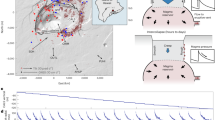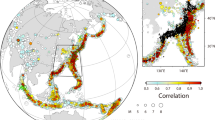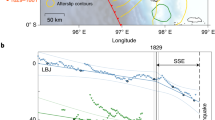Abstract
In subduction zones, stress is released by earthquakes and transient aseismic slip. The latter falls into two categories: slow slip and afterslip. Slow-slip events emerge spontaneously during the interseismic phase, and show a progressive acceleration of slip with a negligible contribution of synchronous tremors or microseismicity to the energy, or moment release1,2,3,4,5,6,7,8,9,10,11,12. In contrast, afterslip occurs immediately after large and moderate earthquakes, decelerates over time, and releases between 20 and 400% of the moment released by the preceding earthquake13,14,15,16,17,18. Here we use seismic and GPS data to identify transient aseismic slip that does not fit into either of these categories. We document a seismic–aseismic slip sequence which occurred at shallow depths along a weakly coupled part of the Andean subduction zone19 in northern Peru and lasted seven months. The sequence generated several moderate earthquakes that together account for about 25% of the total moment released during the full sequence, equivalent to magnitude 6.7. Transient slip immediately followed two of the earthquakes, with slip slowing at a logarithmic rate. Considered separately, the moment released by transient slip following the second earthquake was more than 1,000% of the moment released during the earthquake itself, a value incompatible with classical models of afterslip. Synchronous seismic swarms and aseismic slip may therefore define a stress-release process that is distinct from slow-slip events and afterslip.
This is a preview of subscription content, access via your institution
Access options
Subscribe to this journal
Receive 12 print issues and online access
$259.00 per year
only $21.58 per issue
Buy this article
- Purchase on Springer Link
- Instant access to full article PDF
Prices may be subject to local taxes which are calculated during checkout




Similar content being viewed by others
References
Ozawa, S., Murakami, M. & Tada, T. Time-dependent inversion study of the slow thrust event in the Nankai trough subduction zone, southwestern Japan. J. Geophys. Res. 106, 787–802 (2001).
Dragert, H., Wang, K. & James, T. S. A silent slip event on the deeper Cascadia subduction interface. Science 292, 1525–1528 (2001).
Schwartz, S. Y. & Rokosky, J. M. Slow slip events and seismic tremor at Circum-Pacific subduction zones. Rev. Geophys. 45, 1–32 (2007).
Rogers, G. & Dragert, H. Episodic tremor and slip on the Cascadia subduction zone: The chatter of silent slip. Science 300, 1942–1943 (2003).
Hirose, H. & Obara, K. Repeating short- and long-term slow slip events with deep tremor activity around the Bungo Channel region, southwest Japan. Earth Planets Space 57, 961–972 (2005).
Kao, H., Wang, K., Dragert, H., Kao, J. Y. & Rogers, G. Estimating seismic moment magnitude (Mw) of tremor bursts in northern Cascadia: Implications for the ‘seismic efficiency’ of episodic tremor and slip. Geophys. Res. Lett. 37, L19306 (2010).
Wallace, L. M. & Beavan, J. Diverse slow slip behavior at the Hikurangi subduction margin, New Zealand. J. Geophys. Res. 115, B12402 (2010).
Douglas, A., Beavan, J., Wallace, L. & Townend, J. Slow slip on the northern Hikurangi subduction interface, New Zealand. Geophys. Res. Lett. 32, L16305 (2005).
Delahaye, E. J., Townend, J., Reyners, M. E. & Rogers, G. Microseismicity but no tremor accompanying slow slip in the Hikurangi subduction zone, New Zealand. Earth Planet. Sci. Lett. 277, 21–28 (2009).
Ozawa, S., Suito, H. & Tobita, M. Occurrence of quasi-periodic slow-slip off the east coast of the Boso Peninsula, Central Japan. Earth Planets Space 59, 1241–1245 (2007).
Vallée, M. et al. Intense interface seismicity triggered by a shallow slow slip event in the Central Ecuador subduction zone. J. Geophys. Res. 118, 2965–2981 (2013).
Walter, J. I., Schwartz, S. Y., Protti, J. M. & Gonzalez, V. Persistent tremor within the northern Costa Rica seismogenic zone. Geophys. Res. Lett. 38, L01307 (2011).
Heki, K., Miyazaki, S. & Tsuji, H. Silent fault slip following an interplate thrust earthquake at the Japan Trench. Nature 386, 595–598 (1997).
Yagi, Y., Kikuchi, M. & Sagiya, T. Co-seismic slip, post-seismic slip, and aftershocks associated with two large earthquakes in 1996 in Hyuga-nada, Japan. Earth Planets Space 53, 793–803 (2001).
Suito, H., Nishimura, T., Tobita, M., Imakiire, T. & Ozawa, S. Interplate fault slip along the Japan Trench before the occurrence of the 2011 off the Pacific coast of Tohoku earthquake as inferred from GPS data. Earth Planets Space 63, 615–619 (2011).
Bürgmann, R. et al. Rapid aseismic moment release following the 5 December, 1997 Kronotsky, Kamchatka, earthquake. Geophys. Res. Lett. 28, 1331–1334 (2001).
Pritchard, M. E. & Simons, M. An aseismic slip pulse in northern Chile and along-strike variations in seismogenic behavior. J. Geophys. Res. 111, B8405 (2006).
Perfettini, H. et al. Seismic and aseismic slip on the Central Peru megathrust. Nature 465, 78–81 (2010).
Nocquet, J.-M. et al. Motion of continental slivers and creeping subduction in the northern Andes. Nature Geosci. 7, 287–291 (2014).
Pelayo, A. M. & Wiens, D. A. The November 20, 1960 Peru tsunami earthquake: Source mechanism of a slow event. Geophys. Res. Lett. 17, 661–664 (1990).
Ihmle, P. F., Gomez, J.-M., Heinrich, P. & Guibourg, S. The 1996 Peru tsunamigenic earthquake: Broadband source process. Geophys. Res. Lett. 25, 2691–2694 (1998).
Ekström, G., Nettles, M. & Dziewonski, A. M. The global CMT project 2004–2010: Centroid-moment tensors for 13,017 earthquakes. Phys. Earth Planet. Inter. 201, 1–9 (2012).
Bilek, S. L. & Lay, T. Tsunami earthquakes possibly widespread manifestations of frictional conditional stability. Geophys. Res. Lett. 29, 181–184 (2002).
Dieterich, J. H. Modeling of rock friction experimental results and constitutive equations. J. Geophys. Res. 84, 2161–2168 (1979).
Kawasaki, I. et al. The 1992 Sanriku-Oki, Japan, ultra-slow earthquake. J. Phys. Earth 105–116 (1995).
Perfettini, H. & Avouac, J. Postseismic relaxation driven by brittle creep: A possible mechanism to reconcile geodetic measurements and the decay rate of aftershocks, application to the Chi–Chi earthquake, Taiwan. J. Geophys. Res. 109, B02304 (2004).
Hawthorne, J. C. & Rubin, A. M. Tidal modulation of slow slip in Cascadia. J. Geophys. Res. 115, B09406 (2010).
Ozawa, S. Shortening of recurrence interval of Boso slow slip events in Japan. Geophys. Res. Lett. 41, 2762–2768 (2014).
Nadeau, R. M. & Guilhem, A. Nonvolcanic tremor evolution and the San Simeon and Parkfield, California, earthquakes. Science 325, 191–193 (2009).
Holtkamp, S. G. & Brudzinski, M. R. Earthquake swarms in circum-Pacific subduction zones. Earth Planet. Sci. Lett. 305, 215–225 (2011).
Herring, T. A., King, R. W. & Mcclusky, S. C. Documentation of the MIT GPS Analysis Software: GAMIT v 10.50, Massachusetts Institute of Technology, (2013); http://www-gpsg.mit.edu/~simon/gtgk
Hayes, G. P., Wald, D. J. & Johnson, R. L. Slab1.0: A three-dimensional model of global subduction zone geometries. J. Geophys. Res. 117, B01302 (2012).
Okada, Y. Internal deformation due to shear and tensile faults in a half-space. Bull. Seismol. Soc. Am. 82, 1018–1040 (1992).
Tarantola, A. Inverse Problem Theory (SIAM, 2005).
Radiguet, M. et al. Slow slip events and strain accumulation in the Guerrero gap, Mexico. J. Geophys. Res. 117, B04305 (2012).
Kissling, E., Ellsworth, W. L., Eberhart-Phillips, D. & Kradolfer, U. Initial reference models in local earthquake tomography. J. Geophys. Res. 99, 19635–19646 (1994).
Vallée, M., Charléty, J., Ferreira, A. M. G., Delouis, B. & Vergoz, J. SCARDEC: A new technique for the rapid determination of seismic moment magnitude, focal mechanism and source time functions for large earthquakes using body-wave deconvolution. Geophys. J. Int. 184, 338–358 (2011).
Acknowledgements
This work has been funded by the ANR (Agence Nationale de la Recherche, contract number ANR-07-BLAN-0143-01) and has continuously been supported by the IRD (Institut de Recherche pour le Développement). We thank J. P. Ampuero from Caltech for the use of broadband seismic data from a temporary network in the frame of the Sisnort-08 project. J.C.V.-L. acknowledges support provided by the IRD-DSF through a PhD grant.
Author information
Authors and Affiliations
Contributions
J.C.V.-L. and J.-M.N. carried out fieldwork, GPS analysis and slip inversion; J.C.V.-L. performed the seismicity analysis; J.-M.N. and F.R. performed the rate-and-state calculations; M.V. conducted the source time functions analysis; M.C., F.B. and X.M. carried out GPS fieldwork; H.T. provided seismological data; T.T. performed GPS analysis; J.-M.N., F.R. and J.C.V.-L. wrote the paper. All authors discussed the results and commented on the manuscript.
Corresponding authors
Ethics declarations
Competing interests
The authors declare no competing financial interests.
Supplementary information
Supplementary Information
Supplementary Information (PDF 2394 kb)
Rights and permissions
About this article
Cite this article
Villegas-Lanza, J., Nocquet, JM., Rolandone, F. et al. A mixed seismic–aseismic stress release episode in the Andean subduction zone. Nature Geosci 9, 150–154 (2016). https://doi.org/10.1038/ngeo2620
Received:
Accepted:
Published:
Issue Date:
DOI: https://doi.org/10.1038/ngeo2620
This article is cited by
-
Eight-year catalog of deep short-term slow slip events at the Nankai trough based on objective detection algorithm using strain and tilt records
Earth, Planets and Space (2023)
-
A review on slow earthquakes in the Japan Trench
Progress in Earth and Planetary Science (2023)
-
Tsunami Modeling in the South American Subduction Zone Inferred from Seismic Coupling and Historical Seismicity
Pure and Applied Geophysics (2021)
-
Seismic-Acoustics of a Block Sliding Along a Fault
Pure and Applied Geophysics (2020)
-
Slow-slip events in semi-brittle serpentinite fault zones
Scientific Reports (2018)



